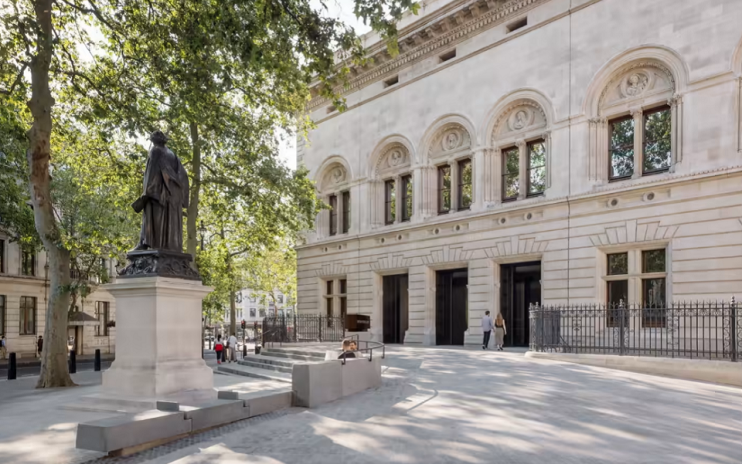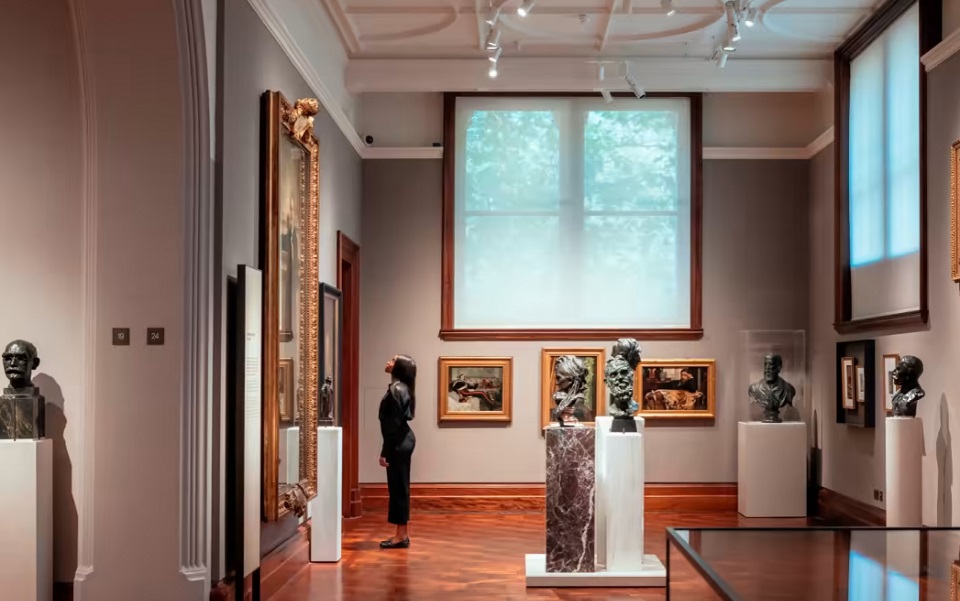Inside the National Portrait Gallery’s smart £41million refurbishment

Finally, there’s a proper entrance! The National Portrait Gallery, closed for refurbishments since 2020, reopened this week. £35 million in investment has bought it a smart new look, and a genuine push for diversity.
There are new galleries and social spaces, but first, the doors. The Portrait Gallery’s pokey side-door entrance on Charing Cross Road always felt like an underpowered means of access to such a prolific set of portraits, and so a spectacular new entrance on the south side of Leicester Square now properly feels the part. It puts the Gallery on a level pegging with the National Gallery on the Trafalgar Square side, with its grand entrance, properly establishing it alongside its peers, you know, all the other London museums that have proper doors. Anyway, onto the portraits…
The new National Portrait Gallery frontage is the only grand refurbishment across a modernisation that reflects society’s push towards diversity and inclusion. A major thread is photography, how in the 1800s the medium represented the working classes for the first time. Street Life in London, featuring John Thomson’s pioneering 1870s images of flower sellers and chimney sweeps, is one significant new reflection on wider society. Material written in the 1870s explains how the portraits display men who “constantly face death to save us from peril.”

Photographs, for the first time, are threaded amongst the Victorian paintings, breaking down the arbitrary assumptions that we must view the mediums separately. In fact, the photographs help bring the paintings to life, demonstrating that mind-bending time in the 1800s when, for a while, the two mediums jostled for space in a dramatically changing world. Nearby, portraying the other half of society, a photograph of Isambard Kingdom Brunel posing in front of an intimidating wall of chains while launching the SS Great Eastern ship is an arresting symbol of power and the industrial age. Of the forces that pushed down on men like those flower sellers.
The Gallery is still best viewed from the top down, so begin with the Tudors on the third floor, where a loan of Meynnart Wewyck’s Margaret Beaufort portrait catches the eye first as you walk in. It’s no accident. “There would be no Tudors without her,” one gallery assistant says of the new addition. It’s true: Beaufort gave birth to Henry VII aged just 13 and here she crouches, praying in later life. This restored piece, on loan from St John’s College, Cambridge, is the earliest known full-length portrait of an Englishwoman and a poignant way to begin a visit to the Gallery that is newly displaying more female perspectives.
Also new for 2023 is the Portrait Miniatures collection on the second floor, asking us to rethink what a portrait actually is. Made on ivory or card, these palm-sized portraits, popular from the 1500s until the Victorian era, can actually feel more intimate than traditional portraits, somehow capturing the whole essence of a person in three inches. Don’t miss in particular the one of Jane Austen, the only known portrait of the artist created in her lifetime. It was drawn by her sister Cassandra and is a humble little joy of a thing to squint at for a while.
Much of the contemporary portraiture has been changed, reflecting the Gallery’s desire to display more of their huge deposit that sits unseen in storage. Gone is the iconic Chris Levine image of Queen Elizabeth II with her eyed closed, incoming is a 2011 portrait of her with Prince Philip and a 2013 portrait of King Charles, formerly Prince Charles, dressed more casually. It is one of the first pieces you see on the ground floor as you enter.
The contemporary pieces – rightly accessible for fleeting visitors on the ground floor for younger or newer audiences – are a predictably colourful wash of contemporaneity: Ed Sheeran posing looking deep in thought, like the opposite of his performer identity, and below that, Michael Eavis with his hands thrown open, purposefully looking like anything but a dairy farmer.
And yet, it’s the upper floors that excite the most: the Gallery has upped its female portraits from 30 to 48 per cent, and on these floors, representing a time when women were rarely celebrated, let alone the subjects of portraits, the push for provocation feels visceral: a portrait of anti-slavery abolitionist Frederick Douglas by Elizabeth Peyton sits below a half-finished portrait of William Wilberforce, the pioneering anti-slavery campaigner whose back condition made sitting for such portraits painful. Captions call out prolific male academics, like Baron Macaulay, for how their successful careers were “actually shaped by empire.” A thrilling romp through history, definitively in the present.
Photos, Jim Stephenson and Oliver Hess. Visit the National Portrait Gallery’s website, npg.org.uk
